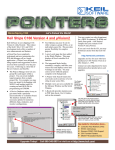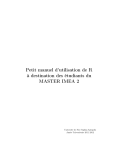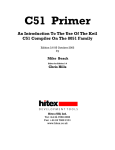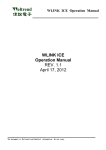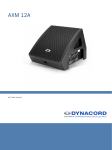Download Application Note 129
Transcript
Application Note
Function Pointers in C51
APNT_129
OVERVIEW
Function pointers are one of the many difficult features of the C programming language. Due to
the unique requirements of a C compiler for the 8051 architecture, function pointers and
reentrant functions have even greater challenges to surmount. This is primarily due to the way
function arguments are passed.
Typically, (for most every chip other than the 8051) function arguments are passed on the stack
using the push and pop assembly instructions. Since the 8051 has a size limited stack (only 128
bytes and as low as 64 bytes on some devices), function arguments must be passed using a
different technique.
When Intel introduced the PL/M-51 compiler for the 8051, they introduced the technique of
storing arguments in fixed memory locations. When the linker was invoked, it built a call tree of
the program, figured out which function arguments were mutually exclusive, and overlaid them.
This was the beginning of the linker's OVERLAY directive.
Since PL/M-51 doesn't support function pointers, the issue of indirect function calls never came
up. However, with C, problems abound. How does the linker "know" which memory to use for
the indirect function's arguments? How do you add functions that are called indirectly into the
call tree?
This document explains how to effectively use function pointers in your C51 programs. Several
examples are used to illustrate the problems and solutions that are discussed. Specifically, the
following topics are discussed.
Casting a Constant Address to a Pointer
Declaring Function Pointers
Problems with Function Pointers in C51
Using the OVERLAY Directive to Fix the Call Tree
Pointers to Reentrant Functions
Page 1 of 10
Revision date: 27-Apr-99
Application Note
Function Pointers in C51
APNT_129
POINTERS TO FIXED ADDRESSES
You can easily type cast numeric addresses into function pointers. There are numerous reasons
to do this. For example, you may need to reset the target and application without toggling the
reset line to the CPU. You can use a function pointer to address 0000h to accomplish this.
You may use the type casting features of Standard C to cast 0x0000 into a pointer to a function at
address 0. For example, when you compile the following line of C code...
((void (code *) (void)) 0x0000) ();
... the compiler generates the following:
; FUNCTION main (BEGIN)
; SOURCE LINE # 3
0000 120000
LCALL
00H
; SOURCE LINE # 4
0003 22
RET
; FUNCTION main (END)
This is exactly what we expected: LCALL 0.
Type casting a numeric constant into a function pointer is a tricky thing. The following
description of the components of the above function call will help you understand how to better
use them.
In the above function call, (void (*) (void)) is the data type: a pointer to a function that takes no
arguments and that returns a void.
The 0x0000 is the address to cast. After the type cast, the function pointer points to address
0x0000. Note that we put parentheses around the data type and the 0x0000. This is unnecessary
if we only want to cast 0x0000 to a function pointer. However, since we are going to invoke the
function, these parentheses are required.
Casting a numeric constant to a pointer is not the same as calling a function through a pointer.
To do that, we must specify an argument list. That is what the () at the end of the line does.
Note that all parentheses in this expression are required. Grouping and precedence are
important.
The only difference between the above pointer and a pointer to a function with arguments is the
data type and the argument list. For example, the following function call...
((long (code *) (int, int, int)) 0x8000) (1, 2, 3);
... invokes a function, at address 0x8000, that accepts three (3) int arguments and returns a long.
Page 2 of 10
Revision date: 27-Apr-99
Application Note
Function Pointers in C51
APNT_129
POINTERS TO FUNCTIONS WITH NO ARGUMENTS
Function pointers are variables that point to a function. The value of the variable is the address
of the function. For example, the following function pointer declaration...
void (*function_ptr) (void);
...is a pointer called function_ptr. Use the following code to invoke the function that
function_ptr points to.
(*function_ptr) ();
Since the function that function_ptr points to takes no arguments, none are passed. That's why
the argument list is empty.
The address that function_ptr calls may be assigned when the variable is declared:
void (*function_ptr) (void) = another_function;
Or, it may be assigned during program execution, at run-time.
function_ptr = and_another_function;
It is important to note that you must assign an address to a function pointer. If you don't, the
pointer may have a value of 0 (if you're lucky) or it may have some completely undetermined
value, depending on how your data memory is used. If the pointer is uninitialized when you
indirectly call a function through it, your program will probably crash.
To declare a pointer to a function with a return value you must specify the return type in the
declaration. For example, the following declaration changes the above declaration to point to a
function that returns a float.
float (*function_ptr) (void) = another_function;
Pretty simple stuff. Just remember where the parentheses go and it's easy.
POINTERS TO FUNCTIONS WITH ARGUMENTS
Pointers to functions with arguments are similar to pointers to functions with no arguments. For
example:
void (*function_ptr) (int, long, char);
...is a pointer to a function that takes an int, a long, and a char as arguments. Use the following
to invoke the function that function_ptr points to.
(*function_ptr) (12, 34L, 'A');
Note that function pointers may only point to functions with three (3) arguments or less. This is
because the arguments of indirectly called functions must reside in registers. Refer to reentrant
functions below for information about pointers to functions that use more than three arguments.
Page 3 of 10
Revision date: 27-Apr-99
Application Note
Function Pointers in C51
APNT_129
CAVEATS OF USING FUNCTION POINTERS
There are several caveats you must be aware of if you use function pointers in your C51
programs.
ARGUMENT LIST LIMITS
Arguments passed to functions through a function pointer must all fit into registers. At most
three (3) arguments can automatically be passed in registers. Refer to the C51 User's Manual to
find out the algorithm for fitting arguments into registers. Do not assume that just any three
argument data types will fit.
Since C51 passes up to three arguments in registers, the memory space used for passing
arguments is not an issue unless the function pointed to requires more arguments. If that is the
case, you can merge the arguments into a structure and pass a pointer to the structure. If that is
not acceptable, you may always use reentrant functions (see below).
CALL TREE PRESERVATION
The C51 tool chain does not push function parameters onto the stack (unless reentrant functions
are used). Instead, function parameters and automatic variables (locals) are stored in registers or
in fixed memory locations. This prevents functions from being reentrant. For example, if a
function calls itself, it overwrites its own arguments and/or locals when it calls itself. The
problem of reentrancy is addressed by the reentrant keyword (see below). Another side-effect
of non-reentrancy is that function pointers can, and usually do, present implementation problems.
In order to preserve as much data space as possible, the linker performs call tree analysis to
determine if some memory areas may be safely overlaid. For example, if your application
consists of the main function, function a, function b, and function c; and if main calls a, b, and c;
and if a, b, and c call no other functions (not even each other); then, the call tree for your
application appears as follows:
MAIN
+--> A
+--> B
+--> C
And, the memory used by A, B, and C may be safely overlaid.
The problem with function pointers comes when the call tree cannot be correctly constructed.
The reason is that the linker cannot determine which function a function pointer references.
There is no automatic way around this problem. However, there is a manual one, albeit a bit
cumbersome.
Page 4 of 10
Revision date: 27-Apr-99
Application Note
Function Pointers in C51
APNT_129
The following two source files help illustrate the problem and make the solution easier to
understand. The first source file, FPCALLER.C, contains a function that calls another function
through a function pointer (fptr).
void func_caller (
long (code *fptr) (unsigned int))
{
unsigned char i;
for (i = 0; i < 10; i++)
{
(*fptr) (i);
}
}
The second source file, FPMAIN.C, contains the main C function as well as the function that is
called indirectly by func_caller (defined above). Note that main calls func_caller and passes the
address of func as an argument.
extern void func_caller (long (code *) (unsigned int));
int func (unsigned int count)
{
long j;
long k;
k = 0;
for (j = 0; j < count; j++)
{
k += j;
}
return (k);
}
void main (void)
{
func_caller (func);
while (1) ;
}
The above two source files compile with no errors. They also link with no errors. The
following call tree is produced in the map file created by the linker.
SEGMENT
DATA_GROUP
+--> CALLED SEGMENT
START
LENGTH
------------------------------------------------?C_C51STARTUP
--------+--> ?PR?MAIN?FPMAIN
?PR?MAIN?FPMAIN
+--> ?PR?_FUNC?FPMAIN
+--> ?PR?_FUNC_CALLER?FPCALLER
-----
-----
?PR?_FUNC?FPMAIN
0008H
000AH
?PR?_FUNC_CALLER?FPCALLER
0008H
0003H
There is a lot of information that can be derived from the call tree even in this simple example.
Page 5 of 10
Revision date: 27-Apr-99
Application Note
Function Pointers in C51
APNT_129
The ?C_C51STARTUP segment calls the MAIN C function this is the ?PR?MAIN?FPMAIN
segment. This components of this segment name may be decoded as: PR is the something in the
PRogram memory, MAIN is the name of the function, and FPMAIN is the name of the source
file where the function is defined.
The MAIN function calls FUNC and FUNC_CALLER (according to the call tree). Note that this
is not correct. MAIN never calls FUNC. But, it does pass the address of FUNC to
FUNC_CALLER. Also note that according to the call tree, FUNC_CALLER does not call
FUNC. This is because it is called indirectly through a function pointer.
The FUNC function in FPMAIN uses 000Ah bytes of DATA which starts at 0008h.
FUNC_CALLER in FPCALLER uses 0003h bytes of DATA which also starts at 0008h. This is
important!
FUNC_CALLER uses memory starting at 0008h and FUNC also uses memory starting at 0008h.
Since FUNC_CALLER invokes FUNC and since both functions use the same memory area we
have a problem. When FUNC gets called (by FUNC_CALLER) it trashes the memory used by
FUNC_CALLER. How did this happen? Don't the Keil C51 Compiler and Linker work?
The cause of the problem here is the function pointer. Whenever you use function pointers, you
will almost always have these types of problems. Fortunately, they are easy to fix. The
OVERLAY linker directive lets you specify how functions are linked together in the call tree.
To correct the call tree shown above, the call to FUNC must be removed from the MAIN
function and a call to FUNC must be inserted under the FUNC_CALLER function. The
following OVERLAY command does just that.
OVERLAY (?PR?MAIN?FPMAIN ~ ?PR?_FUNC?FPMAIN,
?PR?_FUNC_CALLER?FPCALLER ! ?PR?_FUNC?FPMAIN)
To remove or insert references to the call tree, specify the caller first and the callee second.
Tilde ('~') removes a reference or call and the exclamation point ('!') adds a reference or call. For
example, ?PR?MAIN?FPMAIN ~ ?PR?_FUNC?FPMAIN removes the call from MAIN to
FUNC.
After the linker command is adjusted to include the OVERLAY directive to correct the call tree,
the map file appears as follows:
SEGMENT
DATA_GROUP
+--> CALLED SEGMENT
START
LENGTH
------------------------------------------------?C_C51STARTUP
--------+--> ?PR?MAIN?FPMAIN
?PR?MAIN?FPMAIN
+--> ?PR?_FUNC_CALLER?FPCALLER
-----
-----
?PR?_FUNC_CALLER?FPCALLER
+--> ?PR?_FUNC?FPMAIN
0008H
0003H
?PR?_FUNC?FPMAIN
000BH
000AH
And, the call tree is now correct and the variables for FUNC and FUNC_CALLER are now in
separate spaces (and are not overlaid).
Page 6 of 10
Revision date: 27-Apr-99
Application Note
Function Pointers in C51
APNT_129
TABLES OF FUNCTION POINTERS
The following is a typical function pointer table definition:
long (code *fp_tab []) (void) =
{ func1, func2, func3 };
If your main C function calls functions through fp_tab, the link map appears as follows:
SEGMENT
DATA_GROUP
+--> CALLED SEGMENT
START
LENGTH
---------------------------------------------?C_C51STARTUP
--------+--> ?PR?MAIN?FPT_MAIN
+--> ?C_INITSEG
?PR?MAIN?FPT_MAIN
0008H
0001H
?C_INITSEG
+--> ?PR?FUNC1?FP_TAB
+--> ?PR?FUNC2?FP_TAB
+--> ?PR?FUNC3?FP_TAB
-----
-----
?PR?FUNC1?FP_TAB
0008H
0008H
?PR?FUNC2?FP_TAB
0008H
0008H
?PR?FUNC3?FP_TAB
0008H
0008H
The three functions called through the table, func1, func2, and func3, appear as though they are
called by ?C_INITSEG. However, this is incorrect. ?C_INITSEG is the routine that initializes
the variables in your program. These functions are referenced in the initialization code because
the function pointer table is initialized with the addresses of these functions.
Note that the starting area for variables used by the main C function as well as func1, func2, and
func3 all start at 0008h. This won't work because the main C function calls func1, func2, and
func3 (through the function pointer table). And, the variables used in func1, et. al. overwrite
those used in main.
The C51 Compiler and BL51 Linker work in combination to make overlaying the variable space
of function easy when you use tables of function pointers. However, you must declare the
pointer tables appropriately. If you do this, you can avoid using the OVERLAY directive. The
following is a function pointer table definition that C51 and BL51 can handle automatically:
code long (code *fp_tab []) (void) =
{ func1, func2, func3 };
Note that the only difference is storing the table in CODE space.
Page 7 of 10
Revision date: 27-Apr-99
Application Note
Function Pointers in C51
APNT_129
Now, the link map appears as follows:
SEGMENT
DATA_GROUP
+--> CALLED SEGMENT
START
LENGTH
---------------------------------------------?C_C51STARTUP
--------+--> ?PR?MAIN?FPT_MAIN
?PR?MAIN?FPT_MAIN
+--> ?CO?FP_TAB
0008H
0001H
?CO?FP_TAB
+--> ?PR?FUNC1?FP_TAB
+--> ?PR?FUNC2?FP_TAB
+--> ?PR?FUNC3?FP_TAB
-----
-----
?PR?FUNC1?FP_TAB
0009H
0008H
?PR?FUNC2?FP_TAB
0009H
0008H
?PR?FUNC3?FP_TAB
0009H
0008H
Now there is no reference from the initialization code to func1, func2, and func3. Instead, there
is a reference from main to the constant segment FP_TAB. This is the function pointer table.
Since the function pointer table references func1, func2, and func3, the call tree is correct.
As long as the function pointer table is located in a separate source file, C51 and BL51 make all
the correct links in the call tree for you.
FUNCTION POINTER TIPS AND TRICKS
There are some function pointer tricks you can use to make things easier.
USE MEMORY-SPECIFIC POINTERS
Change the function pointer from a generic pointer to a memory-specific pointer. This saves one
(1) byte for each pointer. The examples used so far used declared generic function pointers.
Since functions only reside in CODE memory (on the 8051), one byte may be saved by declaring
the functions pointer as a code pointer. For example:
void (code *function_ptr) (void) = another_function;
If you choose to include the code keyword in your function pointer declarations, make sure you
use it everywhere. If you declare a function that accepts a generic 3-byte function pointer and
the pass it a memory-specific, 2-byte function pointer, bad things will happen!
Page 8 of 10
Revision date: 27-Apr-99
Application Note
Function Pointers in C51
APNT_129
REENTRANT FUNCTIONS AND POINTERS
Keil C51 offers the reentrant keyword for functions that are reentrant. Reentrant functions
expect arguments to be passed on a simulated stack. The stack is maintained in IDATA for small
memory model, PDATA for compact memory model, or XDATA for large memory model. You
must initialize the reentrant stack pointer in STARTUP.A51 if you use reentrant functions. Refer
to the following excerpt from the startup code.
;---------------------------------------------------------------------; Reentrant Stack Initilization
;
; The following EQU statements define the stack pointer for reentrant
; functions and initialized it:
;
; Stack Space for reentrant functions in the SMALL model.
IBPSTACK
EQU
0
; set to 1 if small reentrant is used.
IBPSTACKTOP
EQU
0FFH+1
; set top of stack to highest location+1.
;
; Stack Space for reentrant functions in the LARGE model.
XBPSTACK
EQU
0
; set to 1 if large reentrant is used.
XBPSTACKTOP
EQU
0FFFFH+1 ; set top of stack to highest location+1.
;
; Stack Space for reentrant functions in the COMPACT model.
PBPSTACK
EQU
0
; set to 1 if compact reentrant is used.
PBPSTACKTOP
EQU
0FFFFH+1 ; set top of stack to highest location+1.
;----------------------------------------------------------------------
You must set the equate for which memory model stack you use and set the top of the stack. The
reentrant stack pointer decreases (moves down) as items are pushed onto the stack. A neat trick
for conserving internal data memory is to place all reantrant functions in a separate memory
model like large or compact.
To declare a reentrant function, use the reentrant keyword.
void reentrant_func (long arg1, long arg2, long arg3) reentrant
{
}
To declare a large model reentrant function, use the large and reentrant keywords.
void reentrant_func (long arg1, long arg2, long arg3) large reentrant
{
}
To declare a function pointer to a reentrant function, you must also use the reentrant keyword.
void (*rfunc_ptr) (long, long, long) reentrant = reentrant_func;
There is not much difference between declaring reentrant function pointers and non-reentrant
function pointers.
When using pointers to reentrant functions, more code is generated because arguments must be
pushed onto the simulated stack. However, no special linker controls are required and you need
not mess with the OVERLAY directive.
If you pass more than three (3) arguments to a function that you call indirectly, reentrant function
pointers are required.
Page 9 of 10
Revision date: 27-Apr-99
Application Note
Function Pointers in C51
APNT_129
CONCLUSION
Function pointers are useful and not too terribly difficult to use if you pay attention to the linker
call tree and make sure to use the OVERLAY directive to correct any inconsistencies.
Copyright © 1999 Keil Software, Inc. All rights reserved.
In the USA:
Keil Software, Inc.
16990 Dallas Parkway, Suite 120
Dallas, TX 75248-1903
USA
In Europe:
Keil Elektronik GmbH
Bretonischer Ring 15
D-85630 Grasbrunn b. Munchen
Germany
Sales:
Phone:
FAX:
800-348-8051
972-735-8052
972-735-8055
Phone:
FAX:
(49) (089) 45 60 40 - 0
(49) (089) 46 81 62
E-mail:
[email protected]
[email protected]
E-mail:
[email protected]
[email protected]
Page 10 of 10
Internet: http://www.keil.com/
Revision date: 27-Apr-99










